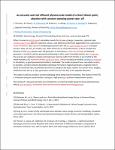An accurate and cost efficient physical scale model of a direct driven point-absorber with constant damping power take-off
| dc.contributor.author | Thomas, S | |
| dc.contributor.author | Giassi, M | |
| dc.contributor.author | Göteman, M | |
| dc.contributor.author | Eriksson, M | |
| dc.contributor.author | Isberg, JM | |
| dc.contributor.author | Hann, Martyn | |
| dc.contributor.author | Ransley, E | |
| dc.contributor.author | Engström, J | |
| dc.date.accessioned | 2019-04-04T09:52:10Z | |
| dc.date.available | 2019-04-04T09:52:10Z | |
| dc.date.issued | 2018 | |
| dc.identifier.uri | http://hdl.handle.net/10026.1/13625 | |
| dc.description.abstract |
When it comes to validating simulation results for wave energy converters, physical scale experiments play an important role as a cost effective preliminary stage before full- scale test. But modelling the power take-off for scale models can be a complex process. State-of-the-art models use static friction or controlled motors to simulate the behavior of the actual power take-off generator. In simulations, of an idealized generator, a constant velocity-proportional damping is often used. Controlled motors can operate this way but are relatively complex and expensive and may suffer from friction or are limited by the motor dynamics. In particular when physical models are compared to simulations, a good parametrized model is invaluable. The model proposed here, uses eddy currents to provide a constant velocity dependent damping: Permanent magnets generate a magnetic field in which an aluminum disc, accelerated by the force acting on the buoy, rotates. As counter force, weights, attached to the disc by a rope, generate a moment to turn the disc in the opposite direction. The system is able to provide a constant damping, while being nearly frictionless. The motion of the PTO is measured using an accelerometer, acting as a high precision position measurement system. The results of 1:10 wave tank tests are compared to a numerical model based on linear potential wave theory, with excellent agreement. | |
| dc.language.iso | en | |
| dc.title | An accurate and cost efficient physical scale model of a direct driven point-absorber with constant damping power take-off | |
| dc.type | conference | |
| dc.type | inproceedings | |
| plymouth.date-start | 2018-07-05 | |
| plymouth.date-finish | 2018-07-06 | |
| plymouth.conference-name | Proceedings of the 5th PRIMaRE Conference | |
| plymouth.organisational-group | /Plymouth | |
| plymouth.organisational-group | /Plymouth/Faculty of Science and Engineering | |
| plymouth.organisational-group | /Plymouth/REF 2021 Researchers by UoA | |
| plymouth.organisational-group | /Plymouth/REF 2021 Researchers by UoA/UoA12 Engineering | |
| plymouth.organisational-group | /Plymouth/Users by role | |
| plymouth.organisational-group | /Plymouth/Users by role/Academics | |
| plymouth.organisational-group | /Plymouth/Users by role/Researchers in ResearchFish submission | |
| dc.publisher.place | Bristol, UK | |
| dcterms.dateAccepted | 2018-01-01 | |
| dc.rights.embargodate | 2023-8-3 | |
| dc.rights.embargoperiod | Not known | |
| rioxxterms.licenseref.uri | http://www.rioxx.net/licenses/all-rights-reserved | |
| rioxxterms.type | Conference Paper/Proceeding/Abstract |


